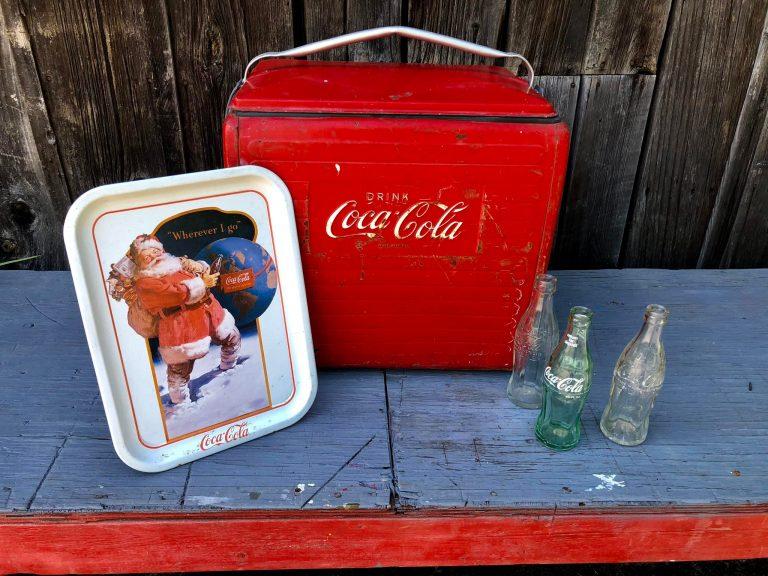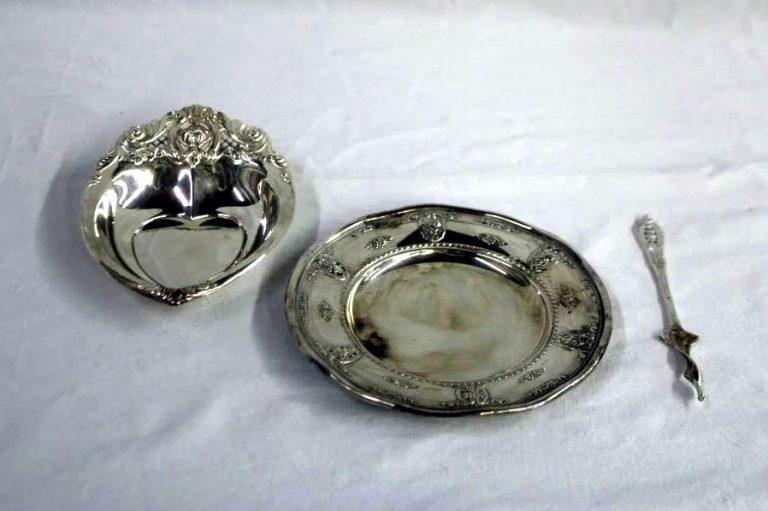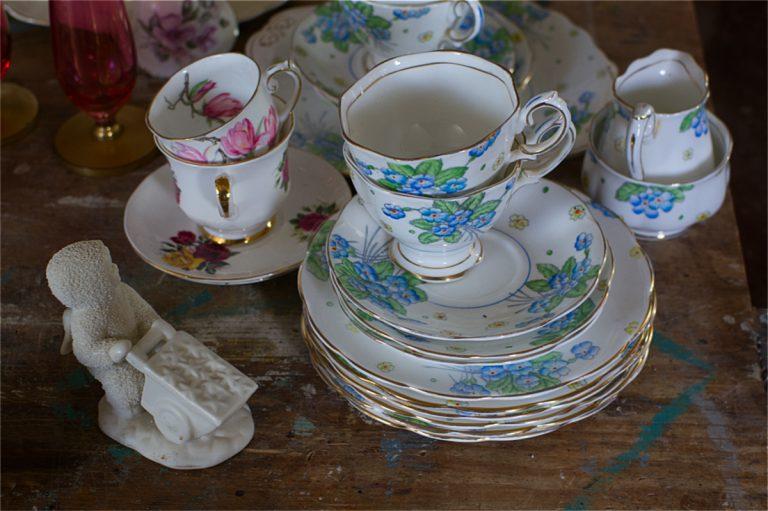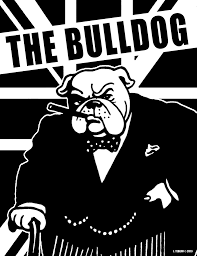The Tale of a Table
Once upon a time, in a land far far away, a young railway engineer came across a poker table. Made in the Arts & Crafts / Mission style popular at the time, of dark-stained quarter-sawn oak, its 36″ round surface had interesting blunted-diamond finials on the legs and a few surprises lurking in the compartments beneath.
There were two removable drawers, one outfitted to hold poker chips and a couple decks of cards. Six large wedge-shaped cubby holes offered the opportunity to hide drinks, cash, maybe even a few spare cards. Possibly even a knife or gun, just in case things got Western…
Fast-forward to modern-day Eastern Ontario. The poker table’s current owner, Lyndsay, has kindly granted me permission to use her name and details. She contacted me for a valuation as she plans to sell the table. I came in with my briefcase full of appraisal gadgets and got to work: measuring, photographing, inspecting and searching for a brand or manufacturer label.

As I worked, Lyndsay told me what she knew about the table: how her mother remembered playing cards on it as a child, and how it had been used in more recent years at the family cottage to hold dishes of food. Hot pads had been used to protect the refinished surface, and it has modern castors on the bottom which can easily be removed.
Clearly there were some areas of scuffing where the stain had been worn through, especially on the cross-stretchers and the edge, but it has no serious damage. Lyndsay joked how the cross-stretchers were there to keep players from kicking each other under the table!
Once I was satisfied with my inspection, as much as possible – I had been unable to find a brand name or label, which galled me – I returned home to begin the research. Especially with no maker’s mark to help narrow it down, I began searching for poker tables.
Quickly I discounted tables that were made of woods other than oak, too tall or too short, too ornate, or too too big a surface area. They were the wrong shape, had features like one central column, reversible wood/green baize surfaces, and drink compartments built into the top.
Soon, one manufacturer name that hit all the marks kept popping up: the name Stickley. In brief, the original Stickley furniture making firm was located in Grand Rapids, Michigan; however in 1900 the eldest of the five Stickley brothers, Gustav (the others were Leopold, Charles, John George and Albert) opened a furniture workshop in Syracuse, NY. Furniture bearing the name of Gustav Stickley is considered to be the best of the best.
And the more research I did into Stickley, the more excited I got. Everything seemed to be correct: the white oak, quarter-sawn; the solid, spare design; age-appropriate slothead screws; through-tensioned cross-stretchers; the shape, height and the apparent finishing touch, the finials. Gustav was well-known for his use of finials, of varying shapes ranging from acorns to pyramids to blunted diamonds.
Soon I found enough close comparables that I wrote up my report and sent it off to Lyndsay, careful to mention that though it had many characteristics of being by Stickley, I could not say with stone-cold certainty that it was a Stickley, but was definitely Arts & Crafts / Mission.
Technically, my job was done. But I still wasn’t satisfied on a personal or professional level. I just had to know, for my own peace of mind, who had made that poker table. I chose to continue delving, of my own accord and at no extra cost to Lyndsay, into the table’s origins.
A gentleman whom I fondly have come to think of as ‘1stDibs Ted’, a wonderfully helpful seller on that site with a Stickley piece for sale, steered me towards Toomey & Co. Auctioneers. They have sold hundreds of pieces of Stickley. I emailed them, enclosing the photos I had taken, and waited for their response. Everything seemed so right.
Meanwhile, I contacted Lyndsay and asked if I could re-visit in order to go over the table with even more of a fine-toothed comb than before.
By now, I knew that Stickley is located in Upper New York, leading me to wonder if Lyndsay’s great-grandpa may have travelled as part of his job and thus came across Stickley. We soon learned that he had been a railway engineer! That could have meant trips Stateside on a regular basis, the opportunity to easily transport pieces of furniture directly from the States, and he may have bought a select piece or two. Like a poker table.
But was this a Stickley poker table, or not? And if not by Stickley, then who? I had learned that early Stickley labels weren’t very big, and brands were also used. Especially with quarter-sawn oak, a fairly small, burnt-in brand might be easy to miss.
We carefully upended the table, and once again I searched. And searched. And searched. Only to find – nothing. Frustrating for me, to say the least, but Lyndsay continued to be cheery and a great sport. She was quite happy with my results and ongoing diligence.
I got home, fired up the computer and was thrilled to see that Lucy Toomey had responded.
She told me that she had seen that particular poker table before.
And it wasn’t a Stickley.
Dang.
But, she did give me a brand name, and that was the Michigan Chair Company. Unfortunately she didn’t have a model name or number to give me, only her own personal recollection. The Michigan Chair Company furniture is considered a more affordable option to the elite Stickley brand.
Hmm. Now this really was roll-up-the-sleeves time. Lucy Toomey’s opinion is still valid, but I like to have indisputable proof. More digging ensued, with more tantalizingly close-but-not-quite results popped up. I scrolled through hundreds of pages of archival Mi Chair (as it is popularly known) images, searching in vain for that poker table.
Then ‘1stDibs Ted’ found an image and told me where to look, and there it was: the one and only photo I have since found online of that particular poker table.
Needless to say, I was elated to finally be able to send to Lyndsay a screenshot. The long-awaited, incontestable proof that her table is a circa 1910 Michigan Chair Company poker table.
I also messaged ‘1stDibs Ted’ to thank him for his help, and I asked the one burning question: Why wasn’t there a maker’s label or brand to be found? His response: ‘It’s actually a very common practice. Why, I have no explanation.’
As a final cherry atop the icing of this cake, I heard back from Robert Hoolsema, current owner of the Michigan Chair Company: ‘The Michigan Chair that made that poker table went out of business in the depression. My grandfather bought the name in the 1940’s and he never made poker tables.’
So we come to the end of my lengthy Tale of a Table. There was so much learning for both Lyndsay and I; she learned things about her great-grandpa that she had never known til now, along with the identity of the poker table.
And I not only learned a vast amount about Stickley furniture, I also made some new, valuable contacts. Thanks to Lucy Toomey, who told me it was by Michigan Chair Company; to Robert Hoolsema; and last but far from least, ‘1stDibs Ted’. Thank you so much! I owe you!
That’s all for now, folks! Have a great weekend.






